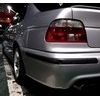Q & A
앞쪽에 트레드가 많이 남은 타이어를 끼우고, 뒤쪽에는 트레드가 적게 남은 타이어를 끼우라고 들었습니다.
제 차는 MB E320 이고 후륜구동 차량입니다. 제 생각에는 엔진의 힘을 받아서 바퀴를 돌리는 뒤쪽에 트레드가 많이 남은 것이 들어가야 할텐데, 제가 다니는 정비소 사장님 말씀으로는 그 반대라고 합니다.
왜 그런가요? 답변 주시는 분들 미리 감사드립니다.
예, 답변 주신 것 감사합니다. 동영상도 잘 봤습니다.
제가 어제 제 차 엔진 마운트를 갈았습니다. 그때 정비소 사장님이 바퀴를 보고는 앞뒤를 바꿔야 한다고 하더군요. 달리다가 앞바퀴가 낡은 것이면 빵꾸가 날 확률이 많아지고 앞바퀴보다 뒷바퀴가 터지는 것이 덜 위험하다고 앞쪽이 새 타이어가 들어가야 한다고 합니다. 그 말씀은 어떻게 생각하세요?
그리고요, 전 엔진 마운트를 갈면 그렇게까지 승차감이 좋아진다는 것을 처음알았습니다. 10년된 차이고, 딱 11만 마일 뛰었는데, 엔진 마운트 갈고나니까 D에 놓고 브레이크를 밟고 있으면 핸들에 엔진 진동의 거의 느껴지지 않습니다. 앞으로 중고차 사면 무조건 엔진 마운트 먼저 갈고 시작해야 할 것같다는 생각이 들더군요.
감사합니다.
보통 FF차량의 경우 트레드 생생한 것을 전륜에 끼우고, 닳은 것을 후륜에 많이들 장착시더라구요...
이론적으로 FF의 경우는 앞쪽에 무게가 많이 실릴 뿐더러, 앞바퀴가 구동+조향+브레이킹 등 상대적으로
많은 일을 해야하기 때문이지요.....사실은 뒷바퀴는 거의 그냥 따라가는 수준^^
하지만 저의 경우는 타이어 위치교환을 굳이 하지 않습니다.(FF든 FR이든 간에)
예를 들어 FF차량의 경우 앞 타이어가 다 되면 앞타이어 만 새걸로 갈아버립니다.
FR차량의 경우도 뒷타이어가 다 되면 뒷타이어 만 새걸로 갈아버립니다.
특별히 심한 편마모증상이 있다면 좌우 교환은 고려해보겠지만, 굳이 전후 교환은
할 필요가 없다는 생각입니다^^

관점의 차이이지만 제 생각은 앞뒤가 같은 타이어 사이즈고 위치교환으로 문제가 없다는 전제하에 정비소 사장님의 말이 더 보편적으로 맞다고봅니다... 게다가 차종이 E320 이라면 후륜의 날림은 전자제어장비가 상당부분커버해주니까..
뒤가 날리는건 속도를 조금 줄이거나 이미 상황이 발생되더라도 카운터스티어링으로 커버할수있지만, 전륜 그립이 없다는것은 제동과 조향 모두를 잃게됩니다.. 한마디로 아무것도 못하고 미끄러지는수밖에 없죠.
물론 가장 좋은 방법은 세원님 말씀처럼 위치교환없이 마모된 2개를 새거로 교환하는 방법이겠죠.. 꼭 4짝을 동시에 갈아야할 필요성은 없으니까요..

타이어의 트레드를 따진다는건 엄밀히 말하면 빗길에서의 그립을 따지는것과 같다고 생각하는데 빗길에서의 수막현상을 동반한 오버스티어는 안겪어본 사람은 절대 모릅니다. 카운터스티어링이든 아무리 뛰어난 자세제어장치든 어림도 없습니다. 차라리 앞으로 쭉~ 미끄러지는게 훨씬 안정적입니다... 빙판길이 아닌이상 완전히 그립을 잃지는 않으니까요... 저도 세원님의 방법을 추천하나 부득이하게 질문의 방법을 써야한다면 트레드가 많이 남은쪽이 뒤로가야 한다고 생각합니다.
마른 노면에서는 트레드가 적은, 그러니까 마모가 많이 진행된 쪽의 그립이 훨씬 뛰어납니다. 래디얼 타이어라면 변하지않는 법칙입니다. 타이어가 닳았다고 '이 타이어는 그립이 나빠졌어'라고 말하는 사람은 타이어 그립을 잘 못느끼는 사람이겠죠.
그렇지만 자동차가 마른노면만 달리는것도 아니고, 빗길 주행에선 타이어의 그루브가 굉장히 중요합니다.
제 생각엔, 전륜이라면 많이 남은쪽을 앞으로 보내는게 훨씬 안전하다고 생각됩니다. 그런데 후륜이면....그래도 앞타이어가 많이 남은쪽이 좋을것같습니다. 트레드가 아무리 없어도 빗길에서 오버스티어를 낼 정도면 속도를 대책없이 너무 많이 낸 상태겠죠. 그에 비해 조향이 안되고 밀리는 것은 속도가 낮아도 일어날수 있습니다.
그런데 이런 얘기가, 트레드가 마모한계선을 이미 넘어서 슬릭화된 정도가 아니면 별 의미없을것 같은데요...마모한계선 넘은 타이어로도 비오는날 와인딩 타봤는데, 어느정도 원하는대로 차가 움직여 주던데요.
하이드로플래닝이 일어날 정도의 속도라면 새타이어를 껴도 별 의미가 없을것같습니다. 비오는 날은 그냥 천천히 달리면 됩니다.

이론적으로야 언제나 균일한 타이어를 앞/뒤로 장착하는게 좋겠지요...
전륜/후륜/사륜 구분할 것 없이 어쩔 수 없이 두 개만 새 타이어를 장착할 경우, 언제나 뒤쪽이 답입니다.
이건 누구의 판단이나 '그렇지 않을까?' 식의 생각대로 우길 문제가 아닌 이미 과학적으로 증명된 "사실"을 토대로 하는 것이기에 앞에 넣니 뒤에 넣니의 논쟁거리가 아닙니다.
빗길 코너, 그리고 직선 고속도로에서의 맞는 횡풍에 뒤 타이어가 제 그립을 발휘하지 못한다면 카운터 스티어링 따위로 미끄러지는 차를 제어하기에는 타쿠미 실력으로도 너무 늦어버립니다.

양쪽 옆에 다른 차가 있는 빗길 고속도로 상황에서 횡풍으로 인해 뒤가 날아가는 스핀이라면 아무것도 부딪치지 않고 정지할 가능성은 없다고 봅니다. 코너에서 그립을 잃고 피쉬테일링 하다가 스핀이면 아무것도 들이 박지 않고 설 가능성 역시 희박합니다.
백문이 불여일견 유튜브 동영상 하나 첨부하겠습니다. 송정렬 회원님도 같은 동영상을 첨부하셨는데 전 Embed 시켜서 다시 올릴게요. ^^ 대충 요지는 '타이어 두 개만 바꿀거면 뒤에다 낑궈!' 구요~
마지막 요점 정리에도 나오는 내용으로,
"Always keep the two tires with the deepest tread on the rear axle. This applies to FWD, RWD, and AWD vehicles."
"항상 가장 수명이 많이 남은(트레드가 많이 남은) 타이어를 뒤 축에 넣어라. 이는 전륜, 후륜 그리고 사륜구동 차량에 적용된다."
라고 두 번째 요약에도 나옵니다.

여러분들이 많이 이용하시는 타이어랙에서도 뒤쪽에 설치할 것을 권장하고 있습니다.
http://www.tirerack.com/tires/tiretech/techpage.jsp?techid=52
Where to Install New Pairs of Tires?
Most vehicles are equipped with the same size tire at every wheel position. Ideally all of these tires should also be of the same type and design, have the same tread depth and be inflated to the pressures specified by the vehicle placard or owner's manual. This combination best retains the handling balance engineered into the vehicle by its manufacturer.
However due to a front-wheel drive vehicle’s front tires' responsibility for transmitting acceleration, steering and most of the braking forces, it's normal for them to wear faster than rear tires. Therefore if the tires aren't rotated on a regular basis, tires will typically wear out in pairs rather than in sets. And if the tires aren't rotated at all, it's likely that the rear tires will still have about 1/2 of their original tread depth remaining when the front tires are completely worn out.
Intuition suggests that since the front tires wore out first and because there is still about half of the tread remaining on the rear tires, the new tires should be installed on the front axle. This will provide more wet and wintry traction; and by the time the front tires have worn out for the second time, the rear tires will be worn out, too. However in this case, intuition isn't right...and following it can be downright dangerous.
When tires are replaced in pairs in situations like these, the new tires should always be installed on the rear axle and the partially worn tires moved to the front. The reason is because new tires on the rear axle help the driver more easily maintain control on wet roads since deeper treaded tires are better at resisting hydroplaning.
Hydroplaning occurs when the tire cannot process enough water through its tread design to maintain effective contact with the road. In moderate to heavy rain, water can pool up in road ruts, depressions and pockets adjacent to pavement expansion joints. At higher speeds, the standing water often found in these pools challenges a tire's ability to resist hydroplaning.
Exactly when hydroplaning occurs is the result of a combination of elements including water depth, vehicle weight and speed, as well as tire size, air pressure, tread design and tread depth. A lightweight vehicle with wide, worn, underinflated tires in a heavy downpour will hydroplane at lower speeds than a heavyweight vehicle equipped with new, narrow, properly inflated tires in drizzling rain.
If the front tires have significantly less tread depth than the rear tires, the front tires will begin to hydroplane and lose traction on wet roads before the rear tires. While this will cause the vehicle to understeer (the vehicle wants to continue driving straight ahead), understeer is relatively easy to control because releasing the gas pedal will slow the vehicle and help the driver maintain control.
However, if the front tires have significantly more tread depth than the rear tires, the rear tires will begin to hydroplane and lose traction on wet roads before the fronts. This will cause the vehicle to oversteer (the vehicle will want to spin). Oversteer is far more difficult to control and in addition to the initial distress felt when the rear of the car starts sliding, quickly releasing the gas pedal in an attempt to slow down may actually make it more difficult for the driver to regain control, possibly causing a complete spinout.
Experience
Members of Tire Rack team had the chance to experience this phenomenon at Michelin's Laurens Proving Grounds. Participants were allowed to drive around a large radius, wet curve in vehicles fitted with tires of different tread depths -- one vehicle with new tires on the rear and half-worn tires on the front and the other with the new tires in the front and half-worn tires on the rear.
It didn't take long for this hands-on experience to confirm that the "proving grounds" name for the facility was correct. The ability to sense and control predictable understeer with the new tires on the rear and the helplessness in trying to control the surprising oversteer with the new tires on the front was emphatically proven.
And even though our drivers had the advantage of knowing we were going to be challenged to maintain car control, spinouts became common during our laps in the car with the new tires on the front and the worn tires on the rear. Michelin advises us that almost every driver spins out at least once when participating in this demonstration!
Experiencing this phenomenon in the safe, controlled conditions of Michelin's Laurens Proving Grounds rather than in traffic on an Interstate ramp in a rainstorm is definitely preferred!
Recommendations
Tires should be serviced periodically following the rotation patterns provided in the vehicle's owner's manual or as established by the industry to help enhance wear quality and equalize front-to-rear and side-to-side wear rates. The minor differences in tread depth between tires that might be encountered immediately after periodic tire rotations at 5,000-7,500 mile intervals won’t upset the vehicle's hydroplaning balance and should not preclude rotating tires. For that matter, any differences in wear rates actually indicate that tire rotations should be done more frequently. Ideally tires should be replaced in complete sets. However when tires are replaced in pairs, the new pair of tires (assuming the vehicle is equipped with the same size tires all of the way around) should always be installed on the rear axle and the existing partially worn tires moved to the front axle.
While insufficient tire rotation intervals and/or out-of-adjustment wheel alignment angles often caused the differences in front-to-rear and side-to-side tire wear rates in the first place, the need to keep deeper treaded tires on the rear axle to resist oversteer conditions caused by wet road hydroplaning is important. Unfortunately this precludes the future possibility of ever rotating tires.
Once a pair of tires has been installed, the only way to escape being forced to drive on mismatched tires continually is to install a complete set of new tires (especially on front-wheel drive vehicles).

저도 일반적으로 FF차량에서는 헌 타이어를 뒷쪽으로 보내는게 맞다고 알고있었는데, 이 글을 읽고 많은 도움이 되었습니다!

음.. 그럼 저의경우(FF차량입니다)..
앞타이어가 다 되어 교체를 할려면 뒷 타이어를 앞으로 당기고 새타이어를 뒤에다
장착을 해야 좀 더 좋겠네요.












앞쪽에 트레드가 적은걸 장착하고 뒤에 새것, 또는 트레드가 많은것을 장착하는게 맞습니다.
앞뒤의 접지력 차이때문에 뒤쪽에 오래된 타이어를 장착하면 오버스티어가 쉽게 일어납니다.
이 동영상 한번 보세요.
http://www.youtube.com/watch?v=--Hb5kQCaTg